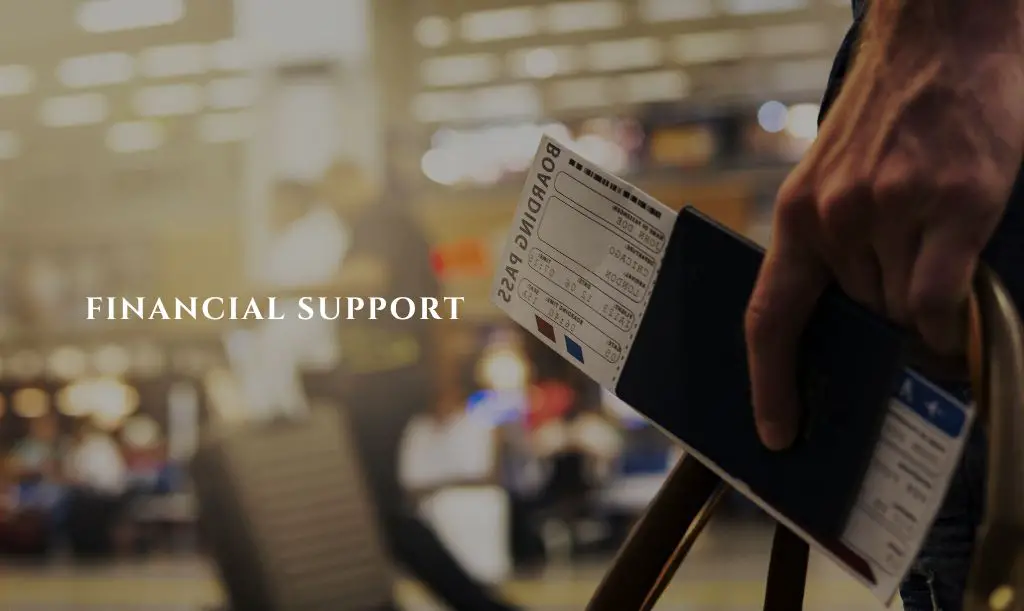Quick question: In a long distance relationship, who pays for travel?
A long-distance relationship can be likened to dancing on a tightrope without a safety net.
It is an arrangement where two individuals find themselves separated by vast distances, leading their lives in separate geographical locations.
These modern-day pioneers are bound together by their shared affection and desire to maintain a meaningful connection despite the physical chasm that separates them.
Importance Of Maintaining A Strong Connection Despite The Physical Distance

The notion of keeping love alive across borders may seem like an impossible feat to some, but for those truly committed souls, it becomes more than just an aspiration; it transforms into an unwavering determination.
Maintaining communication and fostering emotional intimacy lie at the heart of any successful long-distance relationship.
They are beacons that guide us through uncertain times and provide solace when doubts creep in.
Financial Aspect Of Long-Distance Relationships
Money – the inevitable elephant in the room when discussing matters of amour from afar.
The financial aspect adds another layer of complexity to these already intricate relationships.
While true love knows no boundaries or price tags, we must acknowledge that meeting face-to-face requires more than just heartfelt longing; it demands dollars and cents.
The question remains, who should bear the burden of these travel expenses?
Is it a fair and equal responsibility, or should it fall on the shoulders of one partner more heavily?
The Dynamics of Travel Expenses in Long-Distance Relationships
In any long-distance relationship, the issue of who pays for travel expenses can become a delicate matter.
It is crucial to establish a mutual understanding and agreement from the outset.
Both partners need to engage in open and honest discussions about their financial capabilities and limitations.
This means laying all the cards on the table – being transparent about income, savings, and expenses.
Only through this level of communication can both parties fully grasp each other’s financial situations and come to a fair arrangement.
Open Communication About Financial Capabilities And Limitations

Financial matters should not be seen as taboo topics in long-distance relationships.
In order to navigate the complexities of paying for travel, it is essential to have open communication about each other’s financial capabilities and limitations.
This involves discussing income sources, debts or loans, monthly expenses, and existing commitments that may impact one’s ability to contribute equally to travel costs.
By having these conversations early on, partners can avoid misunderstandings or resentment that may arise later due to mismatched expectations.
Establishing A Fair And Balanced Approach
When it comes to long-distance relationships, fairness should be at the core of every decision regarding travel expenses.
It is crucial for both partners to feel that they are contributing fairly based on their respective financial situations.
Establishing a balanced approach requires creativity and flexibility – finding solutions that work for both individuals involved.
This could mean taking turns paying for flights or transportation expenses during visits or splitting accommodation costs evenly.
Striving for equity ensures that neither partner feels burdened with an unfair share of financial responsibilities.
Navigating the dynamics of travel expenses in long-distance relationships demands mutual understanding, open communication, and a commitment towards establishing fairness.
By openly discussing finances from the start, couples can avoid unnecessary conflicts and build a strong foundation for their relationship.
Remember, it is not about who pays more or less; it is about finding a balanced approach that respects the financial capabilities and limitations of both partners.
Traditional Gender Roles vs Modern Perspectives
In a time long ago, men were expected to be the providers, the breadwinners who would bear the burden of financial responsibilities.
They were regarded as the sturdy pillars upon which relationships were built.
Women, on the other hand, were confined to domestic duties and nurturing roles.
Their contribution was often undervalued or overlooked entirely when it came to financial matters.
This antiquated mindset persisted for generations, ensnaring love in its suffocating grip.
Society glorified these expectations!
Men were led to believe that their worth was intrinsically linked to their ability to provide for their partners and families.
They bore tremendous pressure to be the sole source of income, often at great personal sacrifice.
Countless men have spent their lives trapped in unfulfilling jobs or unfruitful careers solely because they believed it was their duty to provide materially for their loved ones.
Shifting Dynamics Towards Equality And Shared Responsibilities
But wait!
The tides are turning; change is in the air! It is time we break free from these archaic chains that bind us.
In today’s world, we find ourselves amidst a revolution where traditional gender roles are being redefined, questioned, and dismantled altogether.
Modern perspectives recognize and celebrate equality between partners – an egalitarian approach where both parties share responsibilities, including financial burdens.
This shift towards shared responsibilities breathes new life into relationships by fostering an atmosphere of balance and cooperation.
We now witness more couples embracing an equal footing when it comes to financial matters within long-distance relationships – a resounding victory for progress and fairness.
Splitting Travel Costs (The Balanced Approach)

When it comes to the financial burden of long-distance relationships, a balanced approach is essential.
One effective strategy to ensure fairness and avoid resentment is by alternating the responsibility of paying for flights or transportation expenses.
Enter the “Odd-Even” rule, a creative idea that injects an element of surprise and anticipation into the relationship dynamics.
Here’s how it works: one partner takes charge of odd-numbered visits, covering all related costs, while the other takes charge of even-numbered visits.
This not only ensures an equitable distribution but also keeps things exciting and adds an element of spontaneity to your long-distance connection.
Another way to symbolize this dynamic shift in financial responsibility is by introducing “The Travel Baton.”
This symbolic baton represents the passing on of responsibility from one partner to another for each trip.
Imagining this baton as a tangible object can make it easier for partners to navigate these discussions about who pays for travel.
It serves as a reminder that although finances play a role, both individuals are invested in maintaining their relationship despite the challenges posed by distance.
Sharing Accommodation Costs During Visits
While transportation expenses can be quite hefty in long-distance relationships, accommodation costs also need careful consideration.
One practical solution is exploring affordable options such as Airbnb or staying with friends or family members living in close proximity.
By opting for these alternatives instead of expensive hotels or rental properties, you not only reduce financial strain but also create opportunities to foster deeper connections with loved ones in your partner’s vicinity.
To take this shared responsibility a step further, consider establishing “The Nest Fund,” a joint savings account set aside specifically for future trips together.
By contributing mutually agreed-upon amounts regularly into this fund, you create a sense of collective effort towards building memorable experiences as well as a shared future.
This can be an effective way to not only distribute the financial burden but also to strengthen your commitment and motivate each other to work towards a future where distance is no longer a hindrance.
Financial Support from Family and Friends

In the realm of long-distance relationships, the financial strain of constant travel can be overwhelming.
However, it is crucial to recognize that love knows no boundaries and sometimes, seeking assistance from family and friends can provide a much-needed respite.
Discussing the possibility of financial contributions from loved ones should not be seen as a sign of weakness or dependency, but rather as an opportunity to strengthen connections and bridge the physical gap between partners.
It takes a village to maintain a thriving relationship, and when friends and family offer their support, it creates a sense of unity that cannot be quantified in monetary terms.
Parents’ Support In Covering Travel Expenses
One remarkable aspect of enduring long-distance relationships is the unwavering support that parents often provide.
They understand the challenges faced by couples separated by distance and are willing to lend a helping hand when needed.
The idea of “The Generous In-Laws” is not just creative but also heartwarming.
When parents offer to cover one partner’s trip expenses, it not only relieves financial pressure but also strengthens familial bonds as they actively participate in nurturing their child’s relationship.
This act of generosity can bring partners closer together emotionally while allowing them to focus on building their future together.
Long Distance Relationship Who Pays For Travel? Conclusion
So, in a long distance relationship who pays for travel?
Navigating the complex terrain of financing travel expenses in long-distance relationships requires open-mindedness and adaptability.
While traditional expectations may still linger in society’s subconscious, it is important to challenge these norms and embrace an egalitarian approach where both partners contribute equally according to their means.
Additionally, seeking financial assistance from supportive family members or friends should not be viewed negatively; rather, it can foster unity among loved ones while solidifying connections across geographical distances.
Ultimately, love has no price tag, and when faced with the financial hurdles of long-distance relationships, it is crucial to remember that the investment made in each other’s happiness is immeasurable.
By approaching travel expenses with a shared responsibility mindset and seeking support from loved ones, the trials of distance can be transformed into opportunities for growth and strength in the relationship.
Related Articles:
- https://lovebridgeguides.com/when-a-guy-calls-you-queen/
- https://lovebridgeguides.com/why-do-guys-like-to-lay-on-your-chest/
- Does A Prom Date Mean Anything? (Answered!) - 20 February 2024
- Boyfriend Refers To Me In Third Person (Explained!) - 20 February 2024
- Is Sending Memes Flirting? Find Out Here! - 20 February 2024


